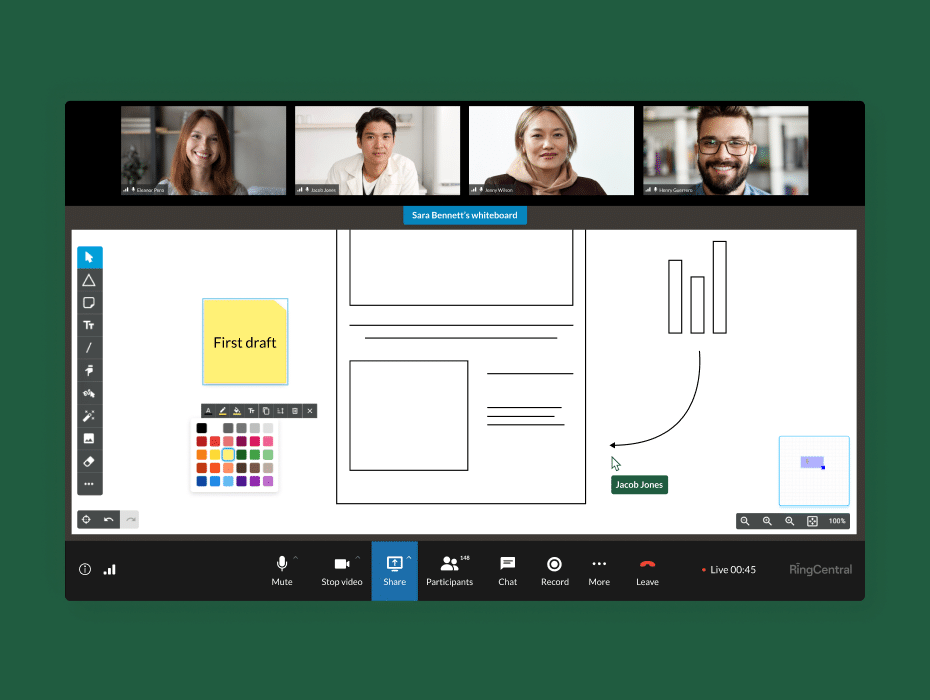We’ve heard a lot in recent years about the revolutionary effects of big data and the internet of things (IoT). They have indeed had big effects in a number of areas, from retail to digital marketing and healthcare.
With so much data at our disposal, however, the difficulty is in knowing how to make use of it. This is where big data analytics comes in.
⭐ Ready to go hybrid or remote? ⭐
Here’s the secret to a successful hybrid and remote-first workplace.
Data analysis allows us to obtain valuable insights while saving time and effort. Without it, we’d be left searching for needles in the proverbial haystack of unstructured data.
Thanks to data science and advanced analytics, however, data mining is greatly simplified, so sifting through a large amount of data is made relatively simple. This, in turn, has a wide range of benefits for businesses and consumers.
What is data analytics?
In short, the term is used to denote the process of delving into raw data and drawing insights and conclusions from it.
Obviously, it’s difficult to get anything coherent out of unstructured data. Data analytics, however, allows organizations to explore large datasets in order to unearth relevant patterns and tendencies. Similarly, text analytics helps to discover meaningful insights from unstructured text.
Data analysts use analytics applications (with capabilities like machine learning and automation) to help them gain useful insights. Open-source data analysis tools like Pandas—a tool built using the Python programming language—are increasingly commonly used.
Even comparatively day-to-day software like Microsoft Excel also offers a range of data analysis features. There’s also Hadoop, a series of open-source programs written in Java, which can be used to process large datasets.
An exploratory data analysis can provide an overview and summary of the main characteristics of datasets. Businesses can then use methods such as data visualization to present the insights they’ve uncovered to wider audiences—including customers and clients—and suggest next steps based on those insights.
Armed with the information gleaned from business analytics, firms are better able to meet the needs and desires of their customers (and to win new ones).
Types of data analytics
There are four basic types of data analytics, and these are as follows:
- Descriptive analytics: Describes what has occurred over a certain period of time. For example, increases in sales or higher page views in a particular month or quarter.
- Predictive analytics: Predicts what is likely to take place in the relatively near term based on previous data.
- Diagnostic analytics: Analyzes why a particular phenomenon (such as an increase or decline in sales) has occurred.
- Prescriptive analytics: Suggests a certain course of action (e.g. a seasonal increase in stocking of a certain product) based on past data.
There’s also regression analysis; this term covers a number of statistical methods used to estimate relationships between a dependent variable and one or more independent variables. This can help to provide insights into the strength of the relationships between variables, and model their future relationships.
By analyzing historical data, we can make better business decisions as we’re more able to anticipate fluctuations in consumer demand, and to understand why these occur. This, if used properly, should ultimately translate into better profitability and a healthier bottom line.
However, data quality and efficient data management matter a great deal. If your data are substandard or somehow unreliable, you won’t be able to optimize your business decisions as you would otherwise. Structured data is indispensable.
Benefits of data analytics
Now that we’ve defined data analytics and outlined its different types, we need to look at the potential benefits it can offer businesses. There are numerous applications of data, so it’s probably best if we concentrate on a few in particular here.
Some of the key benefits of data analytics include:
- More precise marketing: With the help of data analytics, you can get to know your target audience better. You have a clearer appreciation of what they’re looking for and what they need. This allows you to target them more precisely with better-crafted campaigns, including via social media.
- Better decision making: Following on from our previous point, data analytics allows businesses to sharpen their decision-making skills. Equipped with a more thorough understanding of their customer base and their own performance, they can use the insights obtained via data analytics to make improved decisions as well as making project management more effective.
- Enhanced efficiency: Thanks to data analytics, it’s possible for businesses to streamline many of their processes, thus rendering them more efficient while also enabling them to cut costs. Thus, it also helps them with financial analysis, enabling them to deploy their resources more efficiently. For instance, with regard to targeted marketing campaigns.
- Improved customer service: Last but by no means least, data analytics can also help businesses to improve their overall standard of customer service. Firstly, it provides in-depth insights into what customers want and their preferences. Secondly, storing data in a single central location and allowing your whole customer service team to access it can help to ensure better consistency of service quality.
How businesses can use data analytics
We’ve talked about how data professionals—data scientists and engineers—make use of data analytics, but it’s worth stopping to discuss how businesses make practical, everyday use of it. This is a challenging undertaking because the volume of data involved is so substantial. It’s important, therefore, to give careful thought to applications of data analytics.
As we’ve noted, unearthing genuine insights without good data analytics techniques is often very difficult. Here’s a step-by-step look at how businesses use data analytics, and the key questions they have to consider throughout the data analytics life cycle:
- Planning and strategy: Before doing anything else with regard to data analytics, businesses must ensure that they have a long-term plan and clear objectives in mind. They must ask themselves questions about their data requirements: Namely, why they want to collect certain types of data (to learn more about customer interactions, for example) and what they hope to achieve.
- Collecting data: Once businesses are clear in their own mind about the purpose of data analytics, they then need to determine which data sources they’ll be using, which data points they’ll be concentrating on and how to collect that data. Some simply use transaction and social media data, while others use high-tech sources including GPS and RFID chips.
- Ensuring data is relevant: We mentioned earlier that raw data tells us very little at first glance. Businesses have to ensure that the quantitative data they collect is relevant and that they know how to make sense of it. Simply hoovering up huge quantities of data does little good—and may prove to be actively counter-productive.
- Making effective use of data: Businesses which intend to deploy data analytics must think carefully about how they intend to do so, and provide sufficient resources for the purpose. Which metrics do you plan to use? Some businesses employ in-house data analysts, which can give them the edge over competitors, but for smaller firms, employing their own data specialists is unlikely to be viable.
- Presenting data: Earlier, we mentioned the importance of data visualizations in presenting findings and rendering them more comprehensible. Tools like Tableau can help businesses with visualizing data in the form of charts and graphs. These can then make data presentation aids. For instance, in video tutorials and webinars, as well as for the eye-catching infographics that prove popular on sites like LinkedIn.
- Acting on new insights: It’s one thing gaining all these insights via data analytics, but businesses must have an action plan in order to put them to practical use. How might certain findings help your business improve the service it provides to customers? How might you use it to reach new customers?
Data analytics technologies
There’s a wide range of data analytical tools that businesses can use, and more are being introduced all the time. Some of the most widely-used data analytics technologies include the following:
- Predictive analytics: We briefly defined predictive analytics earlier, as using old data to forecast future outcomes. Based on statistical algorithms and machine learning (about which, more later), it provides businesses with a clearer idea of what to expect in the relatively near future, allowing them to prepare and position themselves accordingly.
- Data management: Collecting data is one thing, but you need to know how to manage it if you’re going to make effective use of it. Analytics processes and tools are therefore indispensable for managing the flow of data and organizing it. They can help your business ensure that you have high-quality data and that it’s easy to obtain when your teams need it.
- Data warehouse: A kind of management system used to facilitate data analytics and other business intelligence processes. Businesses can use data warehouses to centralize data drawn from various sources, thus making it more manageable and easier to draw insights from. It can also come to serve as a useful historical record which data analysts can use to make long-term comparisons.
- Machine learning: A subset of artificial intelligence (AI), machine learning essentially involves the simulation or approximation of human intelligence in completing tasks. As the name implies, it involves applications which can analyze data and learn from it over time, ensuring that it gradually becomes more and more accurate at predicting outcomes.
Why is data analytics so important?
If you’re still wondering what all the fuss is about when it comes to data analytics, perhaps this will convince you: Just look at what some of the biggest businesses in the world are doing, and how seriously they’re taking it. Firms such as Amazon are eagerly seizing on the opportunities provided by big data to help them know their customers inside out.
Data analytics is widely used in retail today, and in the healthcare sector. The travel and hospitality industries have also enthusiastically adopted data analytics, as it enables them to develop a much more detailed understanding of what their customers want, and how to resolve potential problems.
The stark reality is this: If your business isn’t making good use of data science, then there’s a high chance that its rivals already are. This could leave you at a serious competitive disadvantage. But if you take advantage of the opportunities data analytics offers you, your business could be the one to steal a march on them.
Originally published Apr 17, 2021, updated Feb 07, 2023





